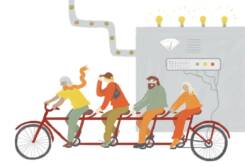Decentralized system
The administration of the Finnish earnings-related pension system is decentralized. This means that there are many pension providers, and they differ in type. Decentralization is closely linked to the basic function of the earnings-related pension system, which is to secure current and future earnings-related pensions.
Content of this page
Division into private and public sectors is at the core of decentralization
The Finnish earnings-related pension system consists of pension schemes in the private sector and the public sector, which differ from each other slightly.
In the past, the contents of the pensions provided through the private and public sector pension schemes were somewhat different, both between and within sectors. The private sector initially had differences in the accrual of pension security that depended on the length of the employment relationship. For a long time, the public sector also had differences both between municipalities and between municipalities and the state. The private and public sectors differed, for example, in the criteria for determining the pensionable age for old-age pensions. These differences have been eliminated and pension laws have been harmonized over the years. Today the content of pension provision is largely the same for both private and public sector employees.
Pension schemes in the private and public sectors also differ in structure.
The actors in the private-sector pension system are pension insurance companies, company pension funds and industry-wide pension funds offering statutory employment pensions, as well as the Seafarers’ Pension Fund established through separate laws and the Farmers’ Social Insurance Institution Mela. Whereas pension insurance companies, company pension funds and industry-wide pension funds are allowed to insure earnings-related pensions for both employees and self-employed persons, the Seafarers’ Pension Fund only insures work coming under the legislation on seafarers’ pension. Mela, in turn, has the exclusive right to provide insurance as defined in the Farmers’ Pensions Act.
At present, Keva acts as a pension provider for the public sector. It manages pension provision for employees in the municipal sector, wellbeing services counties, the state, the Evangelical Lutheran Church, Kela and the Bank of Finland. However, with regard to the financing of pensions, Keva is only responsible for the pensions of the personnel of its own member bodies, i.e. municipalities and wellbeing services counties.
The State Pension Fund, the Church Pension Fund, Kela and the Bank of Finland are responsible for financing the pensions of their own employees. They used to be responsible for arranging pension provision in its entirety, but since the 2010s, the implementation of their pensions has been centralized in Keva while the financial responsibility has remained unchanged.
Decentralization has a long tradition
Since its inception in the early 1960s, the implementation of the Finnish earnings-related pension system in the private sector has been built according to the decentralized model. The roots of decentralization go even deeper. As early as the 19th century, relief funds were set up in connection with factories. Some of them also granted pension benefits. In addition, municipalities and cities began to create retirement plans for municipal office holders in the early 20th century — each body had its own scheme. Moreover, separate laws on pension provision for state’s civil servants have been enacted since the 1920s.
Underlying the statutory earnings-related pension system of the current type, and its decentralized implementation, were the general political situation and the associated conflicts of the late 1950s, which concerned the distribution of income between agrarian population and wage earners. As a result, the wish was that the organization of earnings-related pension provision for employees, which became necessary at that time, should not be given to the Social Insurance Institution or any other party under political steering.
In consequence, the committee planning the pension system at the time stated that the earnings-related pension provision should be based on a decentralized organization. The implementation was entrusted to existing institutions: some employers had already a company pension fund or an industry-wide pension fund. The first pension insurance companies were established in connection with life insurance companies. The Seafarers’ Pension Fund, which was established with the entry into force of the Seafarers’ Pensions Act in 1956, had already begun to manage the seafarers’ pension provision.
When the Employees’ Pensions Act came into force in 1962, it provided for decentralization: According to the Act, an employer could arrange earnings-related pension insurance by setting up a company pension fund or an industry-wide pension fund, or by acquiring earnings-related pension insurance from a pension insurance company. Public-sector operators received their own statutory pension schemes slightly later, when the pension system for municipalities was established in 1964 and that for the state in 1967. The Local Government Pensions Institution (subsequently Keva) was established to manage municipal pensions. Until 2011, the State Treasury was responsible for state pensions.
Decentralization helps risk management
The basic function of the earnings-related pension system is to secure the pensions of current and future pensioners. The aim is to perform this task with the minimum pension contributions so that the cost of earnings-related pensions would be as low as possible for payers.
Some of the pension contributions collected annually in the private sector are placed in funds and invested for future pensions. In the public sector, too, some contributions have been collected into buffer funds, which are currently used in part to finance pensions. Thanks to the assets placed into funds and the returns on them, the level of pension contributions can be kept lower than it would be on the basis of covering the mere annual pension expenditure.
The aim is to obtain the highest possible return on the invested assets while keeping the risk within permissible limits. The risk-taking of different pension providers is limited in various ways. For example, the solvency requirements set for private-sector pension providers help to determine the level of risk allowed for investment activities. Solvency regulation does not to apply to public-sector earnings-related pension investors, although there are various restrictions on their investment activities. For example, Keva’s investment activities are regulated by decisions made by administrative bodies. The investment activities of the State Pension Fund, in turn, are governed by an order issued by the Ministry of Finance.
When there are several actors in a decentralized earnings-related pension system, the risks associated with investment and investment decisions can be managed better than if there were only one actor. The investment strategies of pension providers can differ from each other, as do the returns received from one time to the next.
Decentralization also protects pension assets from the risks associated with political decision-making. Thanks to decentralization, our pension assets are largely separate from the State Budget, unlike in many other countries. The state pays part of the pensions of self-employed persons, farmers, state employees and seafarers. However, most Finnish pensions are financed by pension contributions paid by employers, employees and self-employed persons.
Decentralization makes it impossible for the state to intervene in pension assets in situations where general government finances face difficulties. In many other European countries, the state has intervened, for instance, during economic crises. In Finland, owing to decentralization, pension assets are also protected from political cycles. Pension assets cannot be used, for example, to pay off state or municipal debt.
Decentralization benefits both employers and employees
It is the employer’s responsibility to take out earnings-related pension insurance for the employees. In the decentralized model, a private-sector employer has more leeway in deciding the form in which pension insurance is arranged: Whenever possible, the employer can set up a pension fund for the company, join a pension fund already operating in the same industry or become a customer of the selected pension insurance company.
Thus, authorized pension providers in the private sector compete with each other for customers. One of the means of competition is the quality of customer service and various service solutions, targeting both customer companies and the employees insured. In addition, some pension providers may specialize in earnings-related pension insurance in certain sectors, enabling them to offer their special expertise to customers.
The benefits of decentralization and competition are also reflected in the level of pension contributions. From 2023, each pension provider independently sets its expense loading component, which is included in pension contributions and intended to cover the pension provider’s operating costs. This will affect the overall level of pension contribution charged by the provider. In addition, the customer companies of pension insurance companies may be granted a discount on the pension contribution through company-specific customer rebates. Customer rebates are a surplus distributed among the customers of pension insurance companies. The rebates accumulate from investments.
Private-sector pension providers are subject to joint and several liability for bankruptcy
In the private sector, pension providers annually take some of the pension accrued to the insured and put it into a fund in advance. Each actor uses its own assets to vouch for these funded assets.
The decentralized system has ensured that no harm is caused to the retired person or the insured should an individual actor fail in its task. In the private sector, pension providers have joint and several liability for accrued pensions: Should one operator go bankrupt, the pension assets and liabilities for which the provider was responsible would be divided among the remaining providers.

